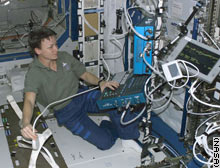NASA's latest experiment may benefit astronauts as well as Earth's inhabitants - and space explorers are overjoyed

An experiment aboard the International Space Station uses ultrasound – low-frequency sound waves – to detect internal injuries in the human body during spaceflight.
The ultrasound tester creates a digital image of the body. The image is sent electronically to doctors, who can diagnose a range of ailments, such as heart problems, collapsed lungs, loss of muscle mass and stomach problems.
NASA, looking to the future and seeing a manned mission to Mars and longer stays in space, welcomes the development of remote-controlled medicine, also known as telemedicine, to protect its astronauts while dealing with shrinking budgets.
"We need the best value for every penny to protect and care for our astronauts," said Victor Schneider, director of NASA's Clinical Research Program.
The astronauts get the royal treatment, but the technology also looks promising closer to home.
Telemedicine technologies use interactive devices, which can be anything from e-mail to satellite communication, to examine patients. In the case of ultrasound, the technology allows researchers to expand the possibilities of their diagnostic tools by connecting to medical facilities on the ground.
Schneider is full of hope that this technology will cause a revolution in the field of medicine, just as the missions to the moon did about thirty years ago.
A technology developed for the Mercury, Gemini and Apollo moon missions and called telemetry, or remote monitoring of vital signs, has saved many lives in intensive care units. These are devices that use computers and body sensors to measure heart rate, breathing and brain activity.
Their use spread in the United States in the 1970s and caused a sharp drop in the rate of deaths in intensive care, from about 40% in the 1960s to just 7% a decade later, Schneider said.
The uses of the new technology on Earth are already beginning.
Researchers recently installed one of the new devices in the locker rooms of the Detroit Red Wings hockey team. Also, the United States Army is using technology to diagnose casualties on the front in Iraq.
Dr. Scott Dolczewski, chairman of the surgery department at Henry Ford Hospital in Detroit, Michigan, and a NASA project researcher, said the experiments may teach us how to use the equipment in emergencies - whether on Mars or in a hockey game.
"There are many similarities between the space station and the Red Wings locker rooms," he said, adding that both the space station and the team's locker rooms could benefit from remote control medicine when full medical help is not available.
This fact may prove to be of enormous importance to NASA.
In the spirit of the space exploration initiative announced by the White House in February, NASA expects to establish a base on the moon and send a manned mission to Mars in the coming decades. Comprehensive medical care in such tasks is necessary.
In preparation for the missions, Schneider said, NASA will devote a significant portion of its resources to the development of telemedicine technologies.
"The development of telemedicine for the mission to Mars will be one of the biggest efforts we intend to make," said Schneider. "We must advance telemedicine one step further."
Researchers said that the performance of the technology so far has been extremely impressive.
"We have proven that we can turn on the devices, receive the images and submit them to the expert," Dolczewski said.
Translation: Dikla Oren
The article on CNN
